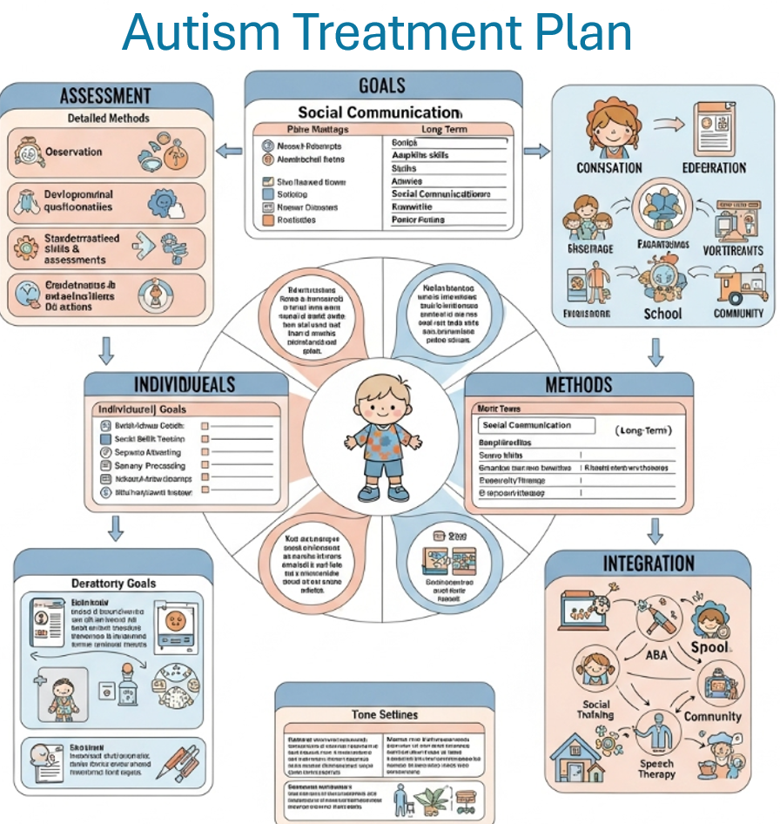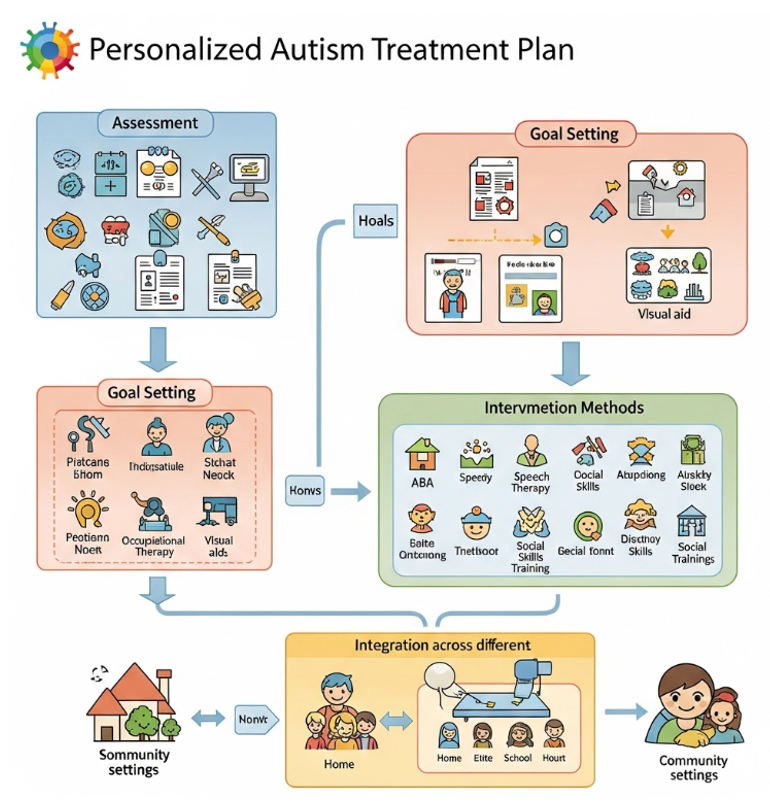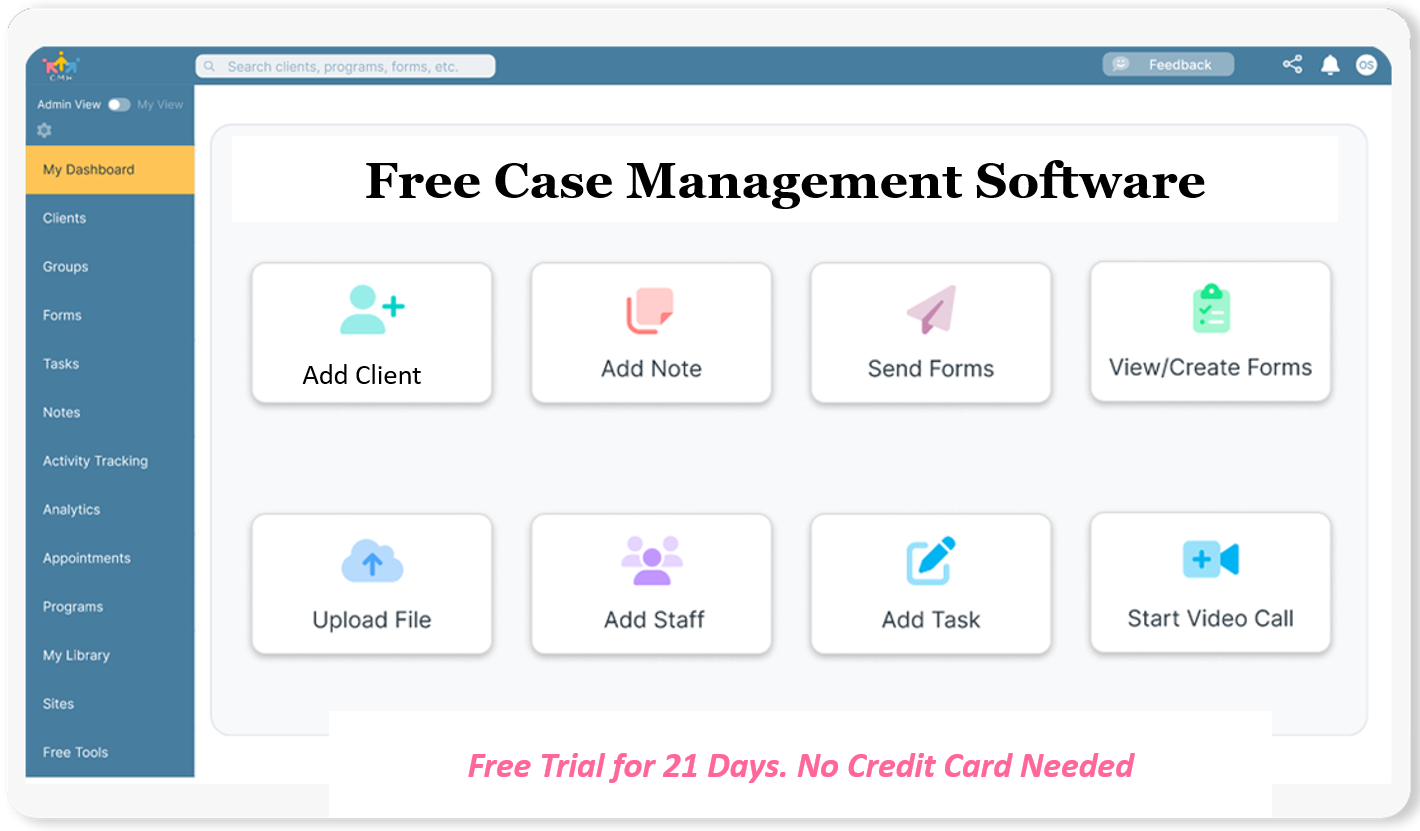How to Apply the Best Autism Treatment Methods for Parents, Therapists, and Educators
Autism therapy refers to a wide range of treatment approaches designed to support children and adults on the autism spectrum. These therapies aim to improve communication skills, social interactions, behavior, and independence. But not all therapies are created equal — and what works for one child may not work for another.
The key is to build a foundation of understanding. That means exploring evidence-based practices, learning the language of autism treatment, and forming a team that centers the individual needs of the child. From this place, real progress is not only possible — it’s likely.

Let’s talk about a use case involving a character called Michelle.
When Michelle first noticed her 3-year-old son, Evan, wasn’t speaking like other kids his age, she chalked it up to him being shy. But as time passed, it became clear that Evan wasn’t just quiet — he was overwhelmed by loud sounds, avoided eye contact, and struggled with even the simplest transitions.
After his autism diagnosis, Michelle was handed a stack of brochures and a referral list of therapists. She left that appointment with more questions than answers.
Michelle’s story isn’t unique. For many parents and caregivers, the journey into autism therapy begins with confusion, fear, and an urgent need to “do the right thing” — fast.
But with so many treatment options available, from ABA to IBI to behavior intervention plans, knowing where to start can feel paralyzing. In this guide, we’ll walk you through the most trusted autism treatment methods and show you how to build an effective, personalized plan.
Whether you’re just beginning, like Michelle, or refining an approach that’s already underway, this article will give you clarity, direction, and hope.

Let’s get started
Watch the video below or read the guide below.
Pro Tip: Don’t rush into a single therapy just because it’s widely recommended. Take time to learn about the different autism treatment methods and talk with professionals who understand your child’s specific strengths and challenges. Personalization makes all the difference.
Table of Contents
Before we dive into the various autism treatment methods and planning strategies, here’s a quick roadmap to help you navigate this guide. Whether you’re searching for clear definitions, therapy comparisons, or real-life examples of autism treatment plans, you’ll find exactly what you need right here.
- What Is ABA Therapy?
- Core Autism Treatment Methods
- Creating a Personalized Autism Treatment Plan
- Free Autism Treatment Tools & Templates
- Behavior Intervention & Support Plans
- Controversial vs. Evidence-Based Treatments
- Putting It All Together
- Frequently Asked Questions
Pro Tip: Bookmark this Table of Contents or keep it open in a separate tab. As you explore different therapies and planning strategies, being able to jump straight to key sections — like free tools, treatment plans, or behavior support — will save you time and help you stay organized.
What Is ABA Therapy?
When Michelle first heard about ABA therapy from her son’s developmental pediatrician, she hesitated. “Applied Behavior Analysis” sounded clinical and intimidating — not the warm, supportive help she was hoping for.
But three months into the program, Michelle began noticing real changes: her son was using more words, having fewer meltdowns, and even starting to play interactively with his younger sister. What felt cold on paper became a lifeline in practice.
ABA therapy, or Applied Behavior Analysis, is one of the most widely used and studied approaches in autism therapy. It’s based on a simple principle: behaviors that are followed by positive outcomes are more likely to be repeated. The goal of ABA is to encourage helpful behaviors and reduce those that may interfere with learning, safety, or daily life.

What ABA Therapy Involves
At its core, ABA is about breaking skills into small, teachable steps and reinforcing each success along the way. Therapy is typically customized to the child’s specific needs and may take place at home, in a clinic, or in school settings.
- Positive reinforcement is central to ABA. When a child performs a desired behavior — like making eye contact, requesting a snack, or brushing their teeth — they receive a reward. That could be praise, a toy, a break, or anything meaningful to them.
- Therapists collect data in every session to track progress and make informed adjustments.
- Skills targeted may include language, motor coordination, social interaction, self-care, and classroom readiness.
Practical Benefits of ABA Therapy
Families choose ABA because it’s practical, structured, and backed by decades of research. Here are some real-world benefits:
- Improves communication and social interaction
- Helps reduce problem behaviors like aggression or self-injury
- Builds independence with routines and daily tasks
- Prepares children for school or community activities
It’s important to note that ABA is not one-size-fits-all. Programs vary in intensity, format, and approach — from early intervention to focused sessions for specific behaviors. The most successful ABA programs are individualized, flexible, and led by professionals who respect the child’s voice and pace.
Pro Tip: When evaluating or recommending an ABA program, look for data-driven plans that incorporate meaningful positive reinforcement aligned with the client’s developmental profile. Effective ABA isn’t rigid — it adapts in real time and respects the individual’s communication style, sensory needs, and learning pace.
Core Autism Treatment Methods
While ABA therapy is one of the most well-known approaches, professionals working with individuals on the autism spectrum often draw from a broader toolkit of treatment methods.
The goal? To offer individualized care that meets the unique needs of each person — whether they’re in early childhood, adolescence, or adulthood.
Evidence-Based Autism Therapy Methods
Here are the most widely used and researched autism treatment methods:
- Applied Behavior Analysis (ABA): A structured, reinforcement-based approach focused on improving specific behaviors. It’s often used to teach communication, self-care, and social skills.
- Intensive Behavioral Intervention (IBI): A form of ABA autism treatment designed for young children, typically involving 20–40 hours of therapy per week. IBI is goal-oriented and intensive, making it a common early intervention option.
- Early Intensive Behavioral Intervention (EIBI): A subcategory of IBI, EIBI therapy is used with children under the age of five and focuses on foundational developmental skills through structured teaching sessions.
- Developmental, Individual Difference, Relationship-Based Model (DIR/Floortime): This therapy emphasizes emotional development and relationships through child-led play and interactions.
- TEACCH (Treatment and Education of Autistic and Communication-related Children): A structured teaching program that focuses on visual learning and routines, often used in school settings.
- Speech and Language Therapy: Focuses on improving verbal and nonverbal communication skills, including social pragmatics and receptive language.
- Occupational Therapy (OT): Helps children build functional independence in daily tasks such as dressing, feeding, and sensory processing.
- Social Skills Groups: Facilitated peer-based learning opportunities that teach communication, cooperation, and emotional regulation.

Matching the Method to the Need
The effectiveness of any treatment hinges on how well it aligns with the individual’s developmental profile, strengths, and goals. For example:
- A nonverbal preschooler might benefit most from EIBI therapy paired with speech support.
- A school-aged student with strong verbal skills but limited social awareness may thrive in a structured social skills group.
- Adolescents preparing for independence may receive more value from a life skills-based OT plan than from early childhood interventions.
Pro Tip: Avoid relying on a single treatment model for all cases. The best outcomes occur when professionals integrate multiple evidence-based methods based on individual assessments, family input, and clearly defined treatment goals.
Creating a Personalized Autism Treatment Plan
Every individual with autism is unique — and so is their path to progress. That’s why the most effective support begins with a personalized treatment plan for autism that reflects the person’s strengths, challenges, developmental stage, and environment.
Let’s walk through the steps to help professionals design a treatment plan that’s practical, goal-oriented, and grounded in evidence-based methods.
Step 1: Start with a Comprehensive Assessment
Before identifying goals, you need to understand the full picture. This includes:
- Developmental history and clinical evaluations
- Speech, motor, and sensory profiles
- Behavior assessments and caregiver input
- Academic and social functioning in school or community settings
Formal tools (e.g., ABLLS-R, VB-MAPP, Vineland-3) can support this process and generate data to guide the next steps.
Step 2: Define Treatment Goals for Autism
Once the assessment is complete, use it to establish realistic, measurable goals. Good treatment goals for autism focus on functionality and independence. Examples may include:
- Increase use of functional communication to request help
- Reduce frequency of task avoidance behaviors
- Improve self-regulation during transitions
- Develop peer interaction skills in group settings
Goals should be SMART: Specific, Measurable, Achievable, Relevant, and Time-bound.

Step 3: Choose the Right Methods and Intensity
Based on the goals and assessment data, choose the right interventions and service intensity. For example:
- A child with severe communication delays may begin intensive therapy for autism using ABA paired with speech therapy.
- A teen with social anxiety might benefit more from weekly group sessions and cognitive-behavioral supports.
Tailor the duration, frequency, and therapy mix to meet individual needs while collaborating with the full care team.
Step 4: Integrate Support Across Settings
Generalization is key. An effective autism treatment plan includes strategies for:
- Home (daily routines, caregiver training)
- School (IEP alignment, collaboration with educators)
- Community (rehearsing real-world social interactions)
Be sure to build in tools that help families and school staff reinforce skills consistently.
Step 5: Monitor, Adjust, and Evolve
Treatment planning is not one-and-done. Regular data reviews, team meetings, and updates to the plan ensure that the intervention remains relevant and effective as the individual grows and progresses.
Pro Tip: Use a living document format for the treatment plan — this makes it easier to adapt goals, methods, and support structures as new information emerges or progress accelerates.
Free Autism Treatment Tools & Templates
One of the most valuable resources you can offer as a professional is a well-structured set of Autism assessment and treatment plan tools. Whether you’re developing a new treatment plan for autism, setting behavior goals, or managing team communications, having clear, editable templates saves time and ensures consistency across cases.
This section features free ABA tools and sample autism treatment plan templates you can download or replicate for use in clinics, schools, or private practice settings.
Autism Treatment Plan Example
A sample autism treatment plan example includes the following:
- Client Overview (age, diagnosis, developmental level)
- Baseline Data from assessments
- Treatment Goals (communication, social interaction, behavior regulation, etc.)
- Chosen Interventions (ABA, OT, speech therapy, etc.)
- Progress Monitoring Plan (frequency, tools used, data collection)
Download a free editable autism treatment plan template
Behavior Intervention Plan (BIP) for Autism
If you’re supporting students with challenging behaviors, a clear BIP is essential. These sample documents align with the principles of positive behavior support plans for autism and may include:
- Target behaviors (e.g., physical aggression, elopement)
- Behavior function (e.g., escape, sensory, attention-seeking)
- Preventive strategies
- Replacement behaviors
- Reinforcement and consequence plan
- Crisis or safety protocols (if needed)
Download free sample BIP templates for individuals with autism
Why Use these Autism Clinical Templates?
Templates reduce guesswork, promote best practices, and help multidisciplinary teams stay aligned — whether you’re designing a 40-hour intensive autism therapy schedule or tracking progress in a school-based intervention program.
Pro Tip: Always tailor templates to each individual. Pre-filled examples are a great starting point, but nothing replaces data-driven customization based on functional behavior assessments and developmental milestones.
Behavior Intervention & Support Plans
For many individuals with autism, especially in school or structured environments, a Behavior Intervention Plan (BIP) or Behavior Support Plan (BSP) is a critical component of treatment.
These plans help manage challenging behaviors by replacing them with more appropriate, functional alternatives — all while supporting the individual’s ability to thrive.

What Is a Behavior Intervention Plan?
A BIP is a formal document developed based on the results of a Functional Behavior Assessment (FBA). It identifies the reasons behind specific behaviors (the function), outlines prevention strategies, and teaches replacement behaviors using positive reinforcement.
You may encounter these terms used interchangeably:
- Behavior intervention plan autism sample
- Sample BIP for autism
- Behavior intervention plans for students with autism
- Positive behavior support plan examples for autism
Each plan typically includes:
- A description of the target behavior (e.g., hitting, eloping, refusal)
- The hypothesized function of the behavior (e.g., escape, attention, sensory stimulation)
- Strategies to prevent the behavior from occurring
- Skills to teach as alternatives
- Positive reinforcement systems
- Crisis or emergency protocols if necessary
- Monitoring and review schedule
Using Behavior Support Plans in Schools
For educators and school clinicians, behavior plans for students with autism are often integrated into IEPs (Individualized Education Programs) or 504 plans. A well-structured plan aligns with academic goals and includes collaboration between teachers, aides, behavior specialists, and families.
For example:
- A behavior support plan for autism might reduce classroom disruptions by using visual schedules and allowing for sensory breaks.
- A positive reinforcement autism strategy may reward a student with extra playtime for completing tasks without aggression.
Pro Tip: The most effective BIPs are not reactive — they are preventive and instructional. Make sure your plan teaches new skills, not just manages behavior. Reinforcement should be immediate, meaningful, and tied directly to desired outcomes.
Controversial vs. Evidence-Based Treatments
In the world of autism therapy, not all treatments are created equal. While many professionals rely on evidence-based practices like ABA, speech therapy, and occupational therapy, there are also numerous controversial treatments for autism that lack scientific support — and in some cases, pose risks.
Understanding the difference is crucial for professionals tasked with making or recommending treatment decisions.
What Makes a Treatment “Evidence-Based”?
An evidence-based treatment (EBT) has been rigorously tested through peer-reviewed research, typically over many years. These methods are evaluated based on their ability to produce consistent, positive outcomes across diverse populations.
Examples of evidence-based treatments include:
- ABA therapy (including IBI and EIBI variations)
- Speech and language therapy
- Occupational therapy with sensory integration
- Cognitive Behavioral Therapy (CBT) for higher-functioning individuals
These interventions are supported by institutions such as the CDC, NIH, and major psychological associations.

What Are Controversial Treatments for Autism?
Controversial or alternative treatments often gain popularity through anecdotal evidence, testimonials, or media attention — but they may lack research, regulation, or ethical oversight. Some common examples include:
- Chelation therapy (used to “remove toxins” but can cause harmful side effects)
- Hyperbaric oxygen therapy (HBOT)
- Facilitated communication (debunked in multiple studies)
- Special diets (like gluten-free/casein-free), which may help some individuals but aren’t universally effective
- Stem cell therapy (promoted in some countries without scientific validation)
While families may be drawn to these options out of hope or frustration, professionals should guide them with empathy and clarity.
How to Respond as a Professional
It’s not uncommon for parents or caregivers to ask about unproven therapies they’ve read about online. Your role is to acknowledge their concerns while grounding the discussion in facts and ethical guidelines.
You might say:
“I understand why you’re exploring every option — that’s completely valid. Let’s take a look at the research together and focus on interventions that are safe, ethical, and most likely to help your child meet their goals.”
Pro Tip: Stay current on trending treatments, even if they’re controversial. Being able to explain why a therapy is or isn’t supported by evidence builds trust with families and reinforces your role as a credible, collaborative partner.
Putting It All Together: Building a Supportive Treatment System
The most effective autism treatment isn’t about one perfect method — it’s about building a comprehensive, flexible system that supports the individual across every environment they engage in: home, school, therapy settings, and the community.
Key Components of a Supportive Autism Treatment System
- Individualized Treatment Plan: Everything starts with a clear, functional treatment plan for autism. It should include:
-
- Measurable goals
- Evidence-based interventions (like ABA, IBI, or speech therapy)
- A progress monitoring system
- Plans for review and adjustment
- Behavior Intervention Plan (if needed): For individuals with behavior challenges, include a well-structured behavior support plan for autism. Use positive reinforcement, teach replacement behaviors, and engage school teams if applicable.
- Trained, Aligned Team Members: Ensure everyone involved — clinicians, educators, aides, family members — understands the treatment goals and uses consistent strategies. Cross-training across settings can improve generalization and reduce frustration.
- Environmental Supports: Visual schedules, sensory-friendly spaces, and communication aids like PECS or AAC devices can significantly increase independence and reduce anxiety.
- Family Engagement: Even in highly clinical settings, families are essential partners. Provide tools like sample behavior intervention plan for autism forms, reinforcement logs, and checklists to help families carry over progress at home.
- Data-Driven Decision Making:Whether you’re running intensive autism therapy or periodic social skills sessions, use real-time data to track progress. This helps you make adjustments before small problems become big setbacks.
A Case Snapshot
Consider a 6-year-old student named Leo who has limited verbal skills and engages in classroom elopement. His system includes:
- A weekly ABA schedule with goals for requesting help
- A sample BIP for autism shared with school staff
- Sensory accommodations during transitions
- Monthly progress reviews with the interdisciplinary team
- A home visual chart to practice morning routines
The integration of these elements — not just one single method — is what leads to long-term gains for children like Leo.
Pro Tip: Build your treatment system around collaboration. The more cohesive the communication between parents, teachers, therapists, and specialists, the more effective your interventions will be.
Frequently Asked Questions (FAQs)
All three fall under the umbrella of applied behaviour analysis for autism. ABA therapy is the broader term for structured, behavior-based intervention. IBI therapy is a more intensive, goal-focused version often used for school-aged children. EIBI therapy targets children under five and emphasizes early skill acquisition during a critical developmental window.
A quality plan is individualized, measurable, and based on data. It clearly outlines treatment goals for autism, methods, progress monitoring tools, and how interventions will be applied across home, school, and community settings.
BIPs should be reviewed regularly — ideally every 30 to 90 days — depending on the intensity of support required. Revisions should be based on data, input from the support team, and any notable changes in the individual’s behavior or environment.
Yes. Many clinicians and educators use autism treatment plan examples, sample BIPs for autism, and positive behavior support plan examples for autism to get started. These tools offer structured guidance and can be customized to suit each case.
Approach the conversation with empathy and professionalism. Acknowledge the parent’s desire to help their child and redirect the discussion toward evidence-based, safe, and effective therapies. Educating without judgment builds trust and promotes long-term collaboration. What is the difference between ABA, IBI, and EIBI therapy?
What makes a strong treatment plan for autism?
How often should a behavior intervention plan be reviewed?
Are there free tools available to support autism treatment planning?
How do I address a parent’s request for a controversial treatment?
Note: Content on this website (casemanagementhub.org) is copyrighted and protected under applicable copyright laws. Unauthorized reproduction, distribution, or use of any content from this Case Management Hub website, without explicit written permission, is strictly prohibited. Read Terms of Use.
Disclaimer: Case Management Hub is an educational resource site. Our content is not medical advice. Always consult a licensed professional for personal guidance. Use of this site does not create a provider-patient relationship. Do not send us personal health information. Read our full disclaimer here: Case Management Hub Disclaimer.
Images source: Adobe stock









